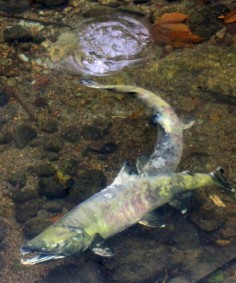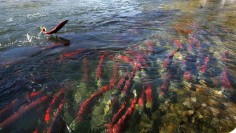
Salmon return to heart of Vancouver after 50-year absence
Environmental improvements including cleaner water and a fish ladder prompt salmon to spawn
The salmon, scarred and exhausted, swim slowly around each other as they near the end of their final journey.
Hook-jawed males snap at each other as they joust for position alongside female fish, which thrash on their sides in the shallows to clear a spot in the gravel bed in which to deposit their precious eggs, before dying.
It's a poignant scene that has played out in countless wildlife documentaries. But the backdrop to this drama is not some remote Canadian wilderness. These chum salmon are spawning in the heart of metropolitan Vancouver, for only the second time in at least half a century.
A Skytrain rumbles past, carrying commuters oblivious to the life-and-death struggle playing out just metres away in tiny Still Creek. One block to the south is a huge Wal-Mart. One block north is Broadway, Vancouver's main east-west thoroughfare. These salmon have made their way under highways and past rail lines, warehouses and tracts of suburbia to end their lives and beget a new generation next to a hardware store's car park.
River restoration expert Dr Ken Ashley said the return of the chum salmon to Still Creek was a pivotal moment for urban streams, which are often overlooked.
"It makes me very happy. It's taken a lot of hard work to get here," said Ashley, director of the Rivers Institute at the British Columbia Institute of Technology.

Ashley said that recent infrastructure improvements had facilitated the return of the spawning salmon, notably the creation of a fish ladder at a nearby dam and the construction of concrete culverts under the Trans-Canada Highway. These allowed the salmon to make their way from the ocean up the Fraser River, then the Brunette River, through suburban Lake Burnaby and ultimately up Still Creek.
The headwaters of Still Creek disappear under the car park of a Canadian Tire hardware store, and are still not much to look at. But the environmental improvements have been huge.
"Twenty years ago, it was a sewer-slash-ditch," said Ashley. "A lot of people give up on these urban areas. But if you stop the pollution at its source, then there's a tremendous ability for these species to come back."
In addition to creating infrastructure to allow salmon to navigate an urban environment, the water quality of Still Creek - once one of the most polluted streams in the region - had to be improved. Municipal authorities enforced the separation of storm water and sewage, and encouraged changes that allowed more rainwater to return to the soil naturally rather than as runoff from concrete.
"[To see salmon return to Still Creek] is a tipping point," said Ashley. "Now that people can see the fish, there is a huge incentive to keep improving it."
Vancouver resident Rochelle Appleby was among a handful of people watching the salmon work up Still Creek on Wednesday. "It's inspiring to think that these salmon can make their way through an urban creek like this," she said. "I ride my bike along here a lot and I never thought it could sustain salmon.
"This whole area is so industrial - to exist among things like Canadian Tire and the Skytrain. You could live right here and not be aware that these are original watersheds. Especially because we are right in an industrial area here; it's not like it's some lovely little creek running through a few houses in the suburbs."
Although salmon famously return to the streams in which they were spawned, Ashley said there was a "stray rate" of about 5 per cent that could account for the fish now in Still Creek.
In addition to the spawning chum, Still Creek now hosted species including cutthroat and rainbow trout and smaller fish like sticklebacks and sculpin, said Ashley. "But nothing as impressive as the chum," he added. "Some of the fish I saw were seven or eight kilos. These are big fish."
On the Menu

: A hefty species that puts up an impressive fight, but is considered relatively poor eating because of its low fat content. Also known as dog salmon, chum are typically eaten canned. 2.5-10kg
: Often spotted jumping clear of the water, coho have orange-red flesh. Considered mid-range in price, texture and flavour. Poach or sautee. 1.5-8kg.
: . The smallest and most common salmon. Known as humpbacks because of the way their body radically transforms during spawning. A light and delicate flesh, relatively low in flavour. Good in pasta or canned. 2-5kg.
: An iconic species, upon which a fine-dining industry was built. Sockeye turn bright red when they spawn. The tastiest and most expensive of all salmon, highly prized for its silky pink or red flesh. Excellent for sashimi, smoked, or anything in between. 1-6kg.
Ian Young

